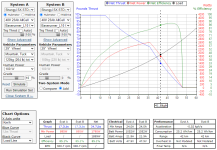I am planning to implement a bicycle project with two-wheel drive AWD:
1. I have a 29" MTB and TSDZ2B 48V 500W OSF, 14AH battery and I would like to support it with a front drive, for example AKM-100H 48V350W, I intend to use two of the same controllers, one integrated with TSDZ, the other purchased for AKM)
Both controllers connected to the VLCD5 display
2. The AWD drive will increase stability in the wet and in corners and increase off-road efficiency.
3. Relieving the engines can reduce energy consumption and increase range, especially in undulating and mountainous terrain.
4. Lightened engines wear less and their resistance to failure increases.
5. Operating costs will decrease because the wear of the cassette/freewheel, chain, spokes and rims will decrease.
6. The cost will decrease because the equipment will be more universal. One bike can replace road, mountain, gravel, MTB.
Currently, the prices of good gravel, mountain and MTB bikes are very high due to the technologies used in them.
Currently, I would like to focus on the mid/hub front drive and consider how to connect the battery, motor controllers and tenso sensors. To ensure smooth distribution of power and torque to the front or rear, depending on road conditions and needs.
I need help in this subject.
1. I have a 29" MTB and TSDZ2B 48V 500W OSF, 14AH battery and I would like to support it with a front drive, for example AKM-100H 48V350W, I intend to use two of the same controllers, one integrated with TSDZ, the other purchased for AKM)
Both controllers connected to the VLCD5 display
2. The AWD drive will increase stability in the wet and in corners and increase off-road efficiency.
3. Relieving the engines can reduce energy consumption and increase range, especially in undulating and mountainous terrain.
4. Lightened engines wear less and their resistance to failure increases.
5. Operating costs will decrease because the wear of the cassette/freewheel, chain, spokes and rims will decrease.
6. The cost will decrease because the equipment will be more universal. One bike can replace road, mountain, gravel, MTB.
Currently, the prices of good gravel, mountain and MTB bikes are very high due to the technologies used in them.
Currently, I would like to focus on the mid/hub front drive and consider how to connect the battery, motor controllers and tenso sensors. To ensure smooth distribution of power and torque to the front or rear, depending on road conditions and needs.
I need help in this subject.


